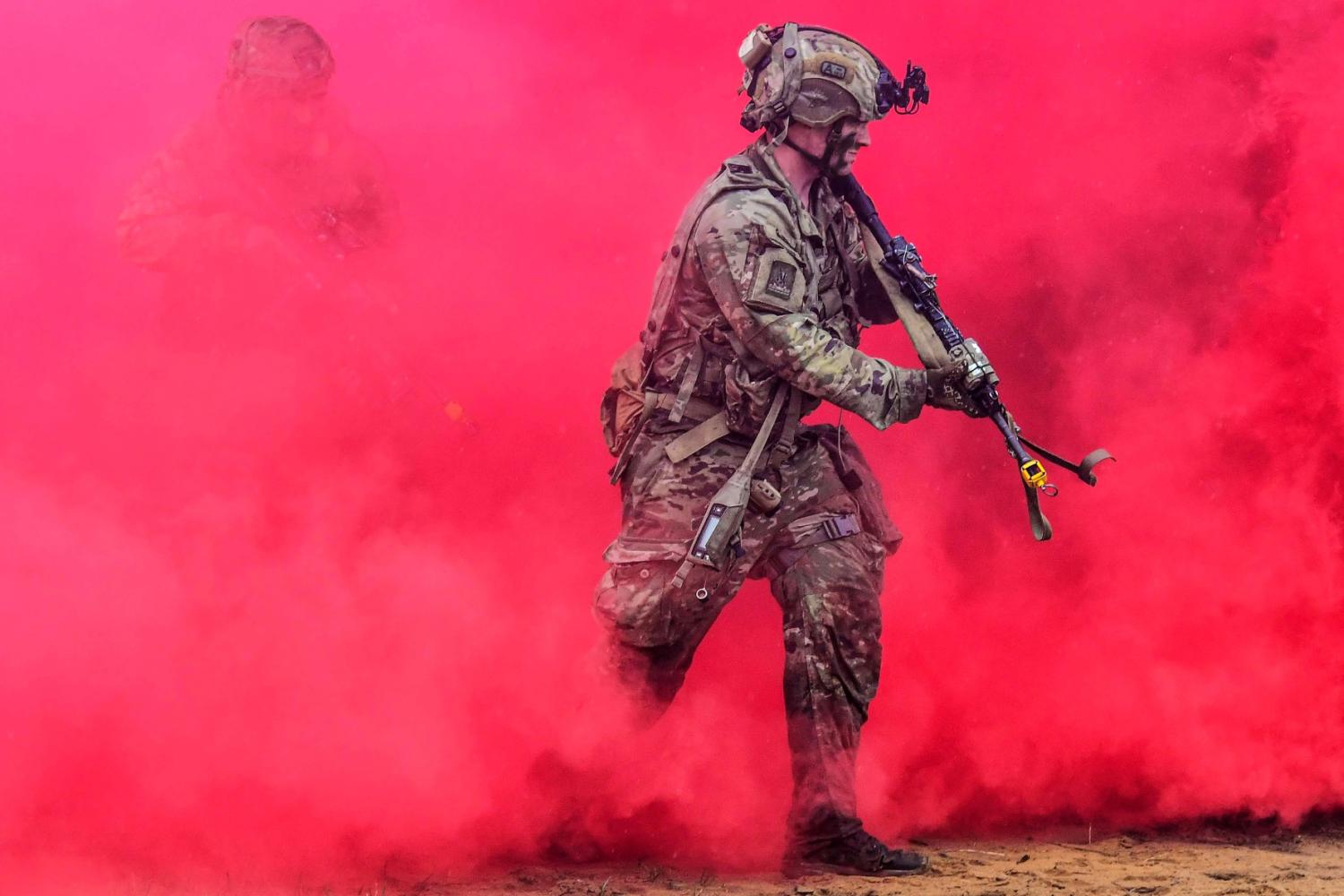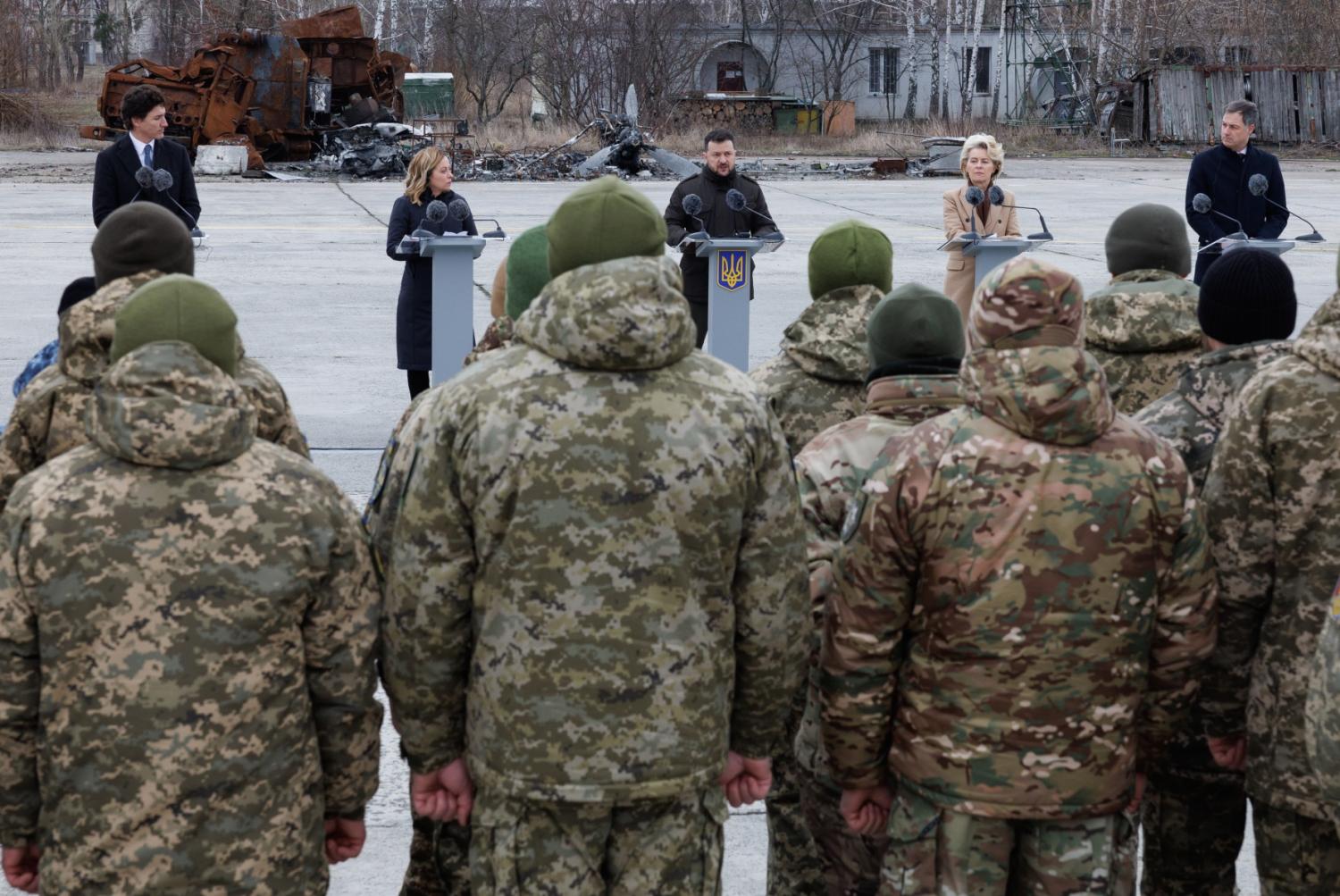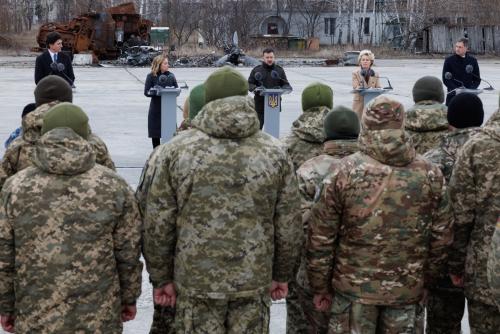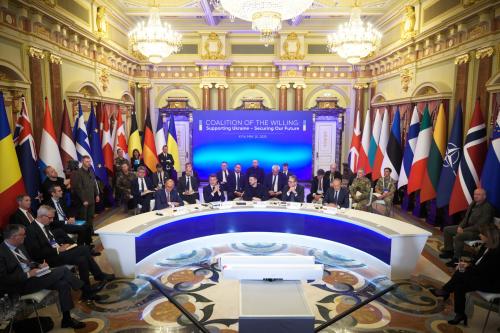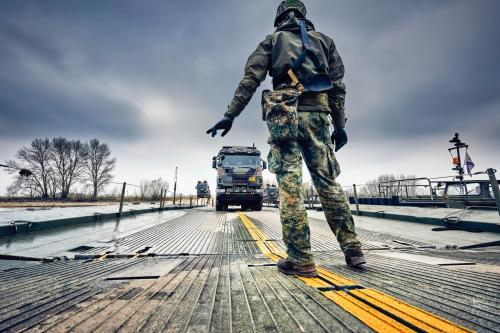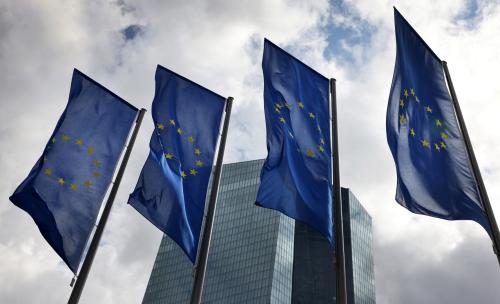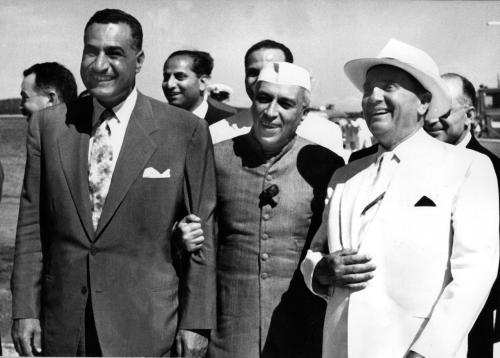This paper was written for a May 14 Center on the United States and Europe virtual workshop on “A new vision for European defense strategy?” as part of Brookings’s Reimagining Europe’s security project, along with Thomas Wright’s “How can Europe defend Ukraine?” and Sophia Besch’s “How must Europe reorganize its conventional defense?”
Two external shocks have fundamentally changed the way Europeans view nuclear deterrence. First, Russia’s full-scale invasion in 2022 heightened the threat perception in Europe, thereby increasing the need for defense and deterrence. The past three years showed that nuclear deterrence seemingly worked in two ways: It protected NATO—a nuclear alliance backstopped by U.S. military preeminence—because Russia has refrained from military escalation, but it also protected Russia because it ensured that the United States would not get directly involved and that transatlantic allies would carefully calibrate their support for Ukraine out of fear of nuclear escalation.
The second shock came with the Trump administration. Washington has increasingly treated Europe not as a partner but as a strategic irritant in the most crucial areas of the transatlantic relationship. Examples range from Vice President JD Vance’s February 2025 Munich Security Conference speech, in which he described Europeans as ideological adversaries, to the potential U.S.-Russian reset and President Donald Trump pressuring Ukraine to end the war on Russia’s terms. In the runup to the 2025 NATO summit, allies seek to keep the United States involved by committing to the 5% GDP defense spending target Trump has been calling for. While for the moment Washington seems to behave constructively within the alliance as long as Europeans spend more, allies worry that the United States is becoming a single-issue nation that only focuses on spending, rather than leading strategic debates and pursuing allied unity. The future of transatlantic trade and investment also burdens the relationship. These events have led European policymakers to question whether Europeans and Americans still share similar political visions, and whether Washington is still a reliable partner or might act against European interests.
These two shocks reinforce preexisting European concerns that the United States might be less interested in Europe, given that it sees China as the key challenge and that the emergence of revisionist powers requires Washington to think beyond Europe. To address these concerns, several politicians and pundits throughout Europe concluded in spring 2025 that the continent would be better off with an independent nuclear deterrent—and leaders from Germany, Poland, and the Baltics signaled an intention to explore alternative solutions. For instance, during a crisis between Washington and Kyiv in February 2025, Germany’s Friedrich Merz declared the United States no longer trustworthy and called for talks on nuclear sharing with Paris. Polish Prime Minister Donald Tusk declared in March 2025 that given the profound change in American geopolitics, Europe would be safer if it had its own nuclear arsenal.
However, the current transatlantic arrangements are neither defunct nor easily replaceable. Also, developing a reliable, independent nuclear deterrent poses much greater challenges than most analysts acknowledge—and there is a fundamental difference between rallying around one of the existing nuclear powers (or both) in Europe (France and the United Kingdom) and developing a common European deterrent. The first would attempt to build upon the existing nuclear arsenals of France and the U.K., thereby further developing the existing nuclear order. The other would fundamentally transform the existing nuclear order in Europe—by either coalescing around a European super-state or by widely expanding the number of European nuclear-weapon states. Therefore, Europeans need to be cautious when defining the challenges ahead and avoid overreactions. In the short and medium term, it is extremely unlikely that they would have to replace the current, U.S.-led system. Rather, it is likely that they will have to substantially complement NATO’s deterrence as Washington will be more reluctant to provide certain security components and might weaken deterrence through dismissive political statements.
If the structural constraints and inherent dilemmas were less stark, we would urge Europeans to adopt clear, decisive solutions that would reduce uncertainty and strengthen the continent’s security. If Washington’s assurances were invalid, the Europeans would need to develop their own version of nuclear deterrence, and they should do so quickly to avoid a deterrence gap. However, the need to navigate difficult trade-offs and considerable uncertainty calls for prioritizing the most feasible solution for the most likely scenario. Against this background, it is better for Europeans to buy time, think through their nuclear options, and concentrate on acquiring powerful conventional forces. This approach, though undoubtedly incomplete and unsatisfying, remains the most realistic and viable option for now—credible intra-European extended deterrence seems currently unlikely and would raise extremely difficult challenges, while a genuinely European nuclear arsenal (in contrast to a national one) would only be meaningful within a politically integrated continent, which is unlikely any time soon.
A strained but enduring transatlantic relationship
Both in public and private, Trump and his key political appointees have clearly stated that Europe is not a priority, expressed disdain for Europe’s political order, and raised doubts about their commitment to the continent’s security. However, members of the Trump administration have repeatedly signaled to the Europeans that the nuclear dimension remains unaffected by other transatlantic quarrels. In fact, the administration has offered numerous assurances that the U.S. nuclear umbrella would remain in place for the long term. The U.S. Department of Defense’s Interim National Defense Strategic Guidance, which was leaked to the press in March, stated that the United States would continue to support Europe with nuclear deterrence of Russia, even if Washington would count on the Europeans to take on various other conventional roles.
The administration’s conventional force posture also offers some reason for cautious optimism. For many allies, the credibility of extended nuclear deterrence is tied to the presence of substantial U.S. conventional forces in Europe. The U.S. Department of Defense has signaled an intention to reassess the U.S. presence on the continent, and the posture review is still underway. And it is possible that decisions to reduce the U.S. presence in Europe might be only taken after the NATO summit, once all key positions in the Pentagon have been staffed and the posture review has been concluded. Then again, indications are that the Trump administration will reduce some presence, such as the additional troops deployed after 2022, but not fundamentally alter its conventional footprint in Europe—which can be read as an indicator of U.S. willingness to continue to provide extended deterrence. While the alliance is increasingly transferring responsibility to Europe—clearly posing difficult adaptation challenges—the core U.S.-led military structure appears largely intact.
Of course, a Russian war of aggression with a clear nuclear dimension on NATO’s border is a fundamentally new phenomenon, and some European allies fear that, combined with the new U.S. administration’s disruptive goals, these new circumstances might fundamentally alter the transatlantic alliance. However, the current situation is actually comparable to earlier transatlantic disagreements that did not result in the collapse of extended nuclear deterrence. Severe economic disputes have often occurred throughout the past eight decades. Political disputes were common; several allies were autocracies for extended periods. Capitals on both sides of the Atlantic repeatedly colluded with Moscow, much to their allies’ dismay.
Lastly, most Europeans believe that, even under the most restrictive interpretation of Trump’s interests, abandoning extended nuclear deterrence toward the continent would be inconsistent with achieving the president’s goals, including maintaining a sufficiently stable international economic order for the administration to achieve its domestic aims. It is undeniable that Trump and many of his associates aim to fundamentally reshape the international system. However, they do not appear entirely indifferent to domestic constraints. This assessment is supported by the administration’s retreat from its maximalist positions when confronted with substantial economic costs. Also, the Trump administration’s current approach to NATO seems to suggest that the U.S. government remains committed to its security assurances and recognizes the strategic importance of allies. While U.S. officials may believe that limited conventional crises in Europe could be regional responsibilities, massive realignments and the chaos associated with the collapse of nuclear deterrence can hardly be in the interest of any U.S. administration. Moreover, Washington appears determined to limit Beijing’s economic and military options. A stable, cooperative Europe is essential to achieving this goal, while a collapsing transatlantic relationship could severely limit U.S. options.
Limited scope for European alternatives
Amidst this backdrop of uncertainty, Europeans turned to the two nuclear powers on the continent, France and the United Kingdom, to consider a European nuclear deterrent with reduced or nonexistent American involvement. Paris has long maintained an autonomous nuclear weapons program, deploying approximately 300 warheads, primarily on strategic nuclear submarines, complemented by an air-based component designed mainly for strategic signaling. France has kept its nuclear arsenal outside NATO’s command structures and does not participate in the alliance’s Nuclear Planning Group. Conversely, London has maintained much closer cooperation with Washington and remains dependent on the United States for the supply of its submarine-launched ballistic missiles. The U.K.’s nuclear forces are committed to NATO’s mission, though operational control remains under British authority.
In recent months, European hopes have increasingly centered on Paris. On the one hand, both the U.K. and France have maintained limited countervalue nuclear arsenals designed to provide credible deterrence against threats to their core national interests, but they are not intended to serve an extended deterrence role. On the other hand, France has for decades declared that its vital interests include a European dimension, and since 2020 has repeatedly invited European partners to explore what greater role it might play in European deterrence. Most recently, President Emmanuel Macron proposed a debate about extending France’s nuclear deterrent to protect European allies. The U.K. has stayed in the background. However, London’s 2025 Strategic Defence Review briefly alludes to nuclear deterrence, and assessments are being conducted regarding the U.K.’s potential redevelopment of an air-based component and reconversion into a nation with dual-capable aircraft to demonstrate commitment.
Even with these aspirations, historical precedent and strategic logic offer little reason to believe that the U.K. or, particularly, France, which has been more active in the debate, absent a counterforce posture and damage-limitation capacity, could credibly replace the United States as a provider of extended nuclear deterrence. Whereas Washington can argue that it possesses the overwhelming conventional forces and large and diverse nuclear capabilities to defend its allies in an all-out nuclear war without necessarily completely sacrificing its own homeland, Paris would face the far more difficult task of convincing its European partners that it is willing to risk its own complete annihilation on their behalf. Moreover, Paris’ allies would need to accept that mutual assured destruction between Russia and France would place any limited nuclear conflict squarely on the territories of the states in between—without those states having any ultimate say over decisions made by French leaders.
Most French officials appear keenly aware of these constraints. Thus, none of the proposals emerging from Paris in recent years suggest anything close to a substitution role for France; rather, they reflect a much more complementary understanding of French nuclear options. French officials repeatedly emphasized that their goal was not to replace Washington’s role, but rather to develop a new deterrence approach for Europe together with their European partners, especially in light of the United States’ increased focus on Asia and on nuclear revisionist powers. However, so far, most French experts have made suggestions that seem to operate within the current framework of U.S. extended deterrence. Some proposed, for example, that European allies participate in French nuclear exercises. The more ambitious French proposals envision European allies refurbishing air bases to accommodate French nuclear bombers. That said, French officials frequently emphasize that Paris is not seeking to bolster its nuclear deterrent, but merely to demonstrate “strategic solidarity.”
At the declaratory level, Paris and London could Europeanize their bilateral declaration that neither could envision a scenario where its vital interests would be threatened without the other’s also being at risk, thereby enlarging the scope of potential nuclear protection. Nonetheless, both Macron and various French officials have explicitly stated that they do not contemplate any arrangement involving shared authority over nuclear employment, nor do they anticipate a substantial enlargement of the French nuclear force.
In addition, France’s past behavior, current interests, and likely domestic political constraints suggest that Paris will not dramatically expand its military capabilities in Europe in the near future. For many allies, Paris has for decades followed a largely national-centered agenda, making few concessions to collective European interests despite regularly calling for European sovereignty. Also, domestic political uncertainty in France casts doubt on whether pro-European forces will remain in power in Paris in the future. This, however, also applies the other way around: France is concerned about engaging in nuclear cooperation with allies that could soon be governed by Eurosceptic or extremist governments.
Going it alone is not a good idea
Considering the difficulties of extended nuclear deterrence, many European commentators and decisionmakers instinctively regard the acquisition of nuclear weapons as the most viable path forward. It is thus not surprising that, in March 2025, the Polish prime minister suggested to his country’s parliament that Warsaw should keep its options open. Most European nations possess the technical expertise and physical resources necessary to develop their own nuclear arsenals. However, embarking on such an undertaking would involve significant costs and considerable time. While some of the world’s most advanced industrial nations would most certainly be able to replicate technologies that are eight decades old, obtaining fissile materials, building reliable warheads, and developing effective delivery systems pose highly complex challenges.
And nuclear proliferation is anything but risk-free. If Europeans misinterpret U.S. commitments while Washington remains dedicated to preserving its order, it is likely to take steps to stop its allies. Past experience suggests that the United States can mobilize substantial diplomatic, economic, and political resources to exert pressure on both friends and adversaries to prevent nuclear proliferation. Conversely, if Washington were to fully abandon its commitment to protecting its allies, Moscow would likely see few reasons to refrain from using all force at its disposal to prevent proliferation. Considering that key nuclear facilities are comparatively easy to identify and strike, and that Russia will continue to hold an escalation edge through its strategic, tactical, and long-range capabilities, European nations will likely face serious challenges in any counterproliferation scenario.
The unintended consequences of a broadly proliferated landscape are even more significant. Should the principal European nations choose to develop nuclear arsenals, numerous secondary powers would likely pursue the same path, culminating in a precarious, nuclear-armed Europe marked by volatile internal and external relations. While these nations might feel more secure vis-à-vis Russia, many would simultaneously fear both deliberate and accidental escalation, and harbor deep suspicions about their neighbors’ intentions—especially in an environment characterized by political polarization and the growing influence of extremist forces across Europe. The pursuit of greater security would paradoxically result in a less secure overall environment.
Centralized power remains an illusion
Both the pursuit of French extended nuclear deterrence and the path of unilateral proliferation confront severe technical challenges, many of which a centrally coordinated United States of Europe would be far better positioned to address or avoid altogether. By vesting the leader of its central government with control over a unified Franco-British nuclear arsenal, such a state could adopt a limited nuclear deterrence posture which, when combined with significant conventional capabilities and weaker transatlantic ties, might plausibly succeed in reassuring those citizens living closer to Russia’s border that deterring nuclear coercion remained credible. Ultimately, this central government’s very legitimacy would rest on its ability to defend the entire territory of the new state, thereby granting its leadership the necessary credibility to sustain such a deterrence posture.
However, the degree of centralization required for such a United States of Europe would demand a level of integration that most European nations regard as illusory within the coming decades. Currently, political, economic, and security goals vary so fundamentally across Europe—shaped by historical legacies, divergent threat perceptions, and competing national priorities—that no polity appears willing to shoulder the political sacrifices or financial burdens required to achieve lasting agreement on shared positions. While Europe’s unity on trade matters often impresses observers across the Atlantic, it is important to note that the continent has struggled to share the costs of averting economic recessions, has yet to implement meaningful decisions to collectively shoulder even moderate portions of the burden of rearmament, and includes states like Austria and Ireland, who are firmly opposed to nuclear deterrence.
Conclusion
Although the idea of acquiring an independent nuclear deterrent may appear intuitive to many Europeans, in reality, the available pathways are either unattainable or burdened with overwhelming technical, political, and strategic challenges. The option that holds greater promise from a technical perspective—deeper European integration—remains a distant prospect. Regrettably, strategies aiming to achieve nuclear deterrence by relying on Paris, developing national arsenals, or adopting minimal integration are either inherently unworkable, linked with enormous challenges, or risk producing profound negative externalities. Although these strategies may appear to provide simple and practical fixes, they ultimately cultivate dangerous illusions among the actors involved, leading to unrealistic expectations. Moreover, while the Trump administration introduces significant and unsettling uncertainties, it remains likely that extended deterrence will endure through the president’s four-year term in office—an assessment that numerous German and other European officials seem to share, despite the alarm politicians expressed at the beginning of the year and the rather excitable expert debate that followed it.
Therefore, Europeans should bide their time and focus on enhancing their conventional forces. Four points stand out. First, while addressing the Trump administration’s demands will be challenging, Europeans should nonetheless strive to keep Washington engaged in European affairs. The planned increases in defense spending and the growing contributions to NATO’s defense planning are part of this strategy. Second, Europeans should dedicate resources to building the capabilities necessary for both preventing Russian aggression and ensuring that any escalation under the nuclear threshold leads to unacceptable costs for Russia. Third, Europeans should consider strengthening the nuclear deterrent role of France and the U.K.—not as a substitute for U.S. capabilities, but as a strengthened complementary pillar of collective defense. Lastly, Europeans should promote robust nuclear dialogue across the continent to explore worst-case scenarios. This includes adapting current nuclear doctrines, expanding existing technological competencies, and assessing the paths to acquiring additional nuclear capabilities.
Despite their efforts, Europeans may one day find themselves in a situation where the United States is no longer willing to provide nuclear deterrence. Therefore, the biggest challenge today is shaping current developments so that Europe does not fall into a “deterrence gap” as a result of U.S. repositioning. The key question is how to maintain the United States’ role in European deterrence and defense while developing alternatives—without giving Washington the impression that it is no longer needed. Ultimately, however, Europeans must recognize that any change in the nuclear order will imply insecurity for allies and enemies alike and that any new European regional model is likely to offer less stability than the current one.
The Brookings Institution is committed to quality, independence, and impact.
We are supported by a diverse array of funders. In line with our values and policies, each Brookings publication represents the sole views of its author(s).


